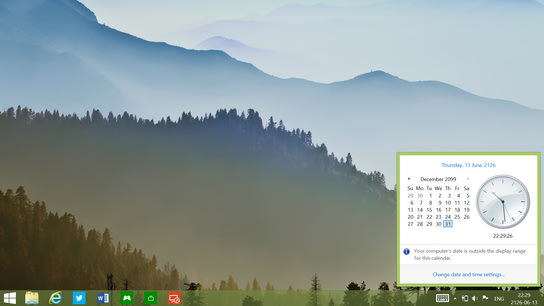I let the battery on my Microsoft Surface 2 run out and left it without a charge for maybe a week. When I booted it up again, Windows 8 thought 40 689 days had elapsed.
I’ve no idea how this could have happened. Interestingly, the clock was correct to the second. It was only the date that was off. To me, this suggest that it wasn’t the internal clock that got confused.
Update (): It’s been eight years since I ran into this problem. Yesterday, Ars Technica published an article that finally answered what happen to me all those years ago. At the time I ran into this issue, Microsoft was testing a then-new-and-still-obscure Windows feature called Secure Time Seeding (STS). STS is known to cause is randomly causing massive jumps in the system date and clocks to this day.
STS was introduced in Windows 8 in November 2015. However, I was running Windows Insider Preview builds at the time. My computer would indeed have had this feature a few months earlier. In the intervening years, I’ve had this happen once more to a Lenovo laptop.
The incorrect system clock caused things like the network time-server synchronization protocol (NTP), HTTPS connections, Windows Update, App Store, and many other system services to fail. You can see from the screenshot that even the Windows calendar gives up past the year 2099.
I had to fiddle around in the system registry to clean out scheduled system maintenance tasks that would next run 111 years in the future.
My Windows login is tied to a Microsoft Account. Luckily, it did not decide to lock me out of the system. A Windows account and the Microsoft Account usually check up on each other on a was up to date.
The problem didn’t correct itself. The NTP service wasn’t working, so the computer had no other time-data source. NTP will disregard any timestamp sent from a time-server that’s implausible out of sync with the system’s local time. I’ve always thought of this as a security/sanity feature, but now I am not so sure anymore.
Some other smaller problems could be seen in Windows Update. The timestamp for the last time it had checked for or installed any updates were set to “Never”. After having manually corrected the time, I’d to fiddle around in the system registry to clean out scheduled system maintenance tasks that would next run 111 years in the future.
The Maya calendar ended in 2012. The Windows 8 calendar seems to end in 2099. It sounds like a good time to predict the next coming Apocalypse.
